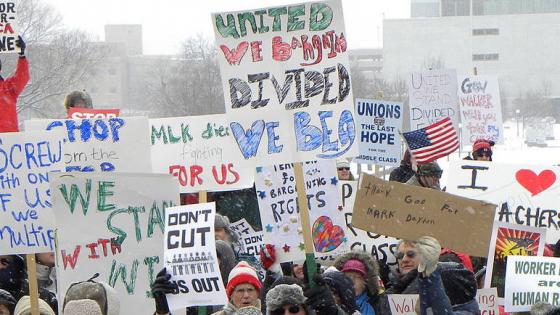The United States labour market is producing too few jobs and those it is producing are often low paid and of poor quality. The latest data release on job creation was disappointing with a rise in total non-farm payrolls of 266,000 against market expectations of more than a million. Real wage stagnation has been a feature of the US economy going back half a century. Even after the bottom part of the wage distribution dropped out in April 2020, as the unemployment rate hit 20%, the mean real weekly wages of production and non-supervisory workers (who make up about four-fifths of the private sector workforce) was only $335 (in constant 1982-1984 dollars), still below the $346 seen in October 1972.
Europeans would be aghast at the low levels of minimum wages and the lack of parental and annual paid leave available to American workers, especially in southern states. The COVID-19 pandemic hasn’t helped. Workers are demanding more paid hours than employers are able to offer, leading to underemployment (Bell and Blanchflower 2021).
This might not be such a problem if the labour market was operating efficiently, with workers being able to find jobs that suit them. Or if workers had means to fix their problems at work. The traditional mechanism available to workers for fixing problems at work is a trades union. Under Wagner Act arrangements in the US, a union has the right to bargain with the employer as the workers’ sole agent to raise wages and improve terms and conditions once a majority of workers have voted union at the workplace. And union representatives can help fix problems at work (grievances, bullying, discrimination) by providing workers with a voice. As Richard Freeman and James Medoff (1984) said 37 years ago, union voice offers workers an alternative to simply quitting when the job gets too much.
Over the last half century there has been a precipitous decline in union membership in the US, especially in the private sector. Today barely 6% of private sector workers in the US are union members. In 17 states that voted for Donald Trump, private sector density is below 4%, while in North and South Carolina and Utah in 2020 private sector union density was below 2%. This is partly a problem of trade union supply rather than union demand: workers often want union representation but can’t access it, leading to what Towers (1997) referred to as a ‘representation gap’. The reason for this is, at least in part, the legal framework surrounding unions’ ability to mount a successful union organising campaign – what John-Paul Ferguson (2008) memorably described as being as hard as getting through the eye of a needle. This is illustrated recently by unions’ inability to win a union vote at Amazon’s huge warehouse in Bessemer, Alabama (Lee 2021).
Also, in the past, where unions did exist, workers were less satisfied with their jobs, not more satisfied. Perhaps union negotiation with employers spilt over into conflict, souring employer-employee relations. Or with the information unionized workers received from their union, they became more aware of the shortcomings of management than they might have been in the absence of a union. Or else job dissatisfaction is the natural by-product of union voice which raises the job dissatisfaction threshold required by workers before they quit, increasing the stock of dissatisfied workers? Whatever the reason, this appeared to be the settled view as to what unions did.
Not anymore. Things have changed.
First, there are signs that union density is on the rise. According to the Bureau of Labor Statistics,1 overall union density has risen by half a percentage point in the last year to 10.8%, although by only a little in the private sector, from 6.2% to 6.3%. Numerically the number of union members has fallen but the decline in employment in the non-union sector explains the rise in density. These union gains are small, but they are potentially very significant because this is the first rise in density in more than a decade.
Second, union workers are now more satisfied than non-union workers. As reported in our last Vox column (Freeman et al. 2020), union members have been more satisfied in their jobs than non-union workers in the United States since the time of the Great Recession. We showed this to be the case with cross-sectional data from the General Social Survey and the Gallup Daily Poll and for European countries.
We have since revisited this issue using panel data for younger and older workers in the National Longitudinal Survey of Youth (NLSY) 1979 and 1997 cohorts (Artz et al. 2021). These panel data confirm that, in contrast to the years before the Great Recession, union workers are now more satisfied than non-union workers.
The effects are quite sizeable and economically meaningful. They are approximately equal in size to the positive impact on job satisfaction of having three employer-provided fringe benefits or having a job in the public versus the private sector (Artz 2010), nearly the value of taking part in an employer-provided profit-sharing scheme (Heywood and Wei 2006) and roughly half the effect of getting a promotion (Kosteas 2011). The findings are important because they show that when a worker becomes unionized that worker’s job satisfaction rises, on average. This indicates that the improvement in union workers’ job satisfaction is not simply an artefact of differential sorting into union status. It might be a causal effect.
So, what has changed? We show that one thing that has not changed much is the union wage premium: the gap in wages earned by union workers relative to their non-union counterparts, ceteris paribus. This premium – which is fairly substantial at over 10% – has remained largely unchanged in the last two decades. Even so, given the wage stagnation experienced by many workers, the sizeable albeit constant wage premium in the union sector may have generated greater job satisfaction since the Great Recession.
We find some diminution in unions’ ability to lower quit rates – albeit confined to older workers – which is suggestive of a decline in their effectiveness in operating as a ‘voice’ mechanism for unionised workers. We also present evidence suggestive of unions’ ability to minimise covered workers’ exposure to underemployment, a phenomenon that has negatively impacted non-union workers. Unions’ ability to help workers avoid underemployment suggests that what seems to have changed is the value attached to the insurance component of the union good. This conjecture is supported by our earlier finding that, prior to the Great Recession, union workers expressed greater apprehension about job loss than non-union workers, an apprehension that has now gone.
This all matters because trade unions have a billing in President Biden’s new New Deal. He came out in solidarity with those Amazon workers seeking to establish a union in Bessemer, Alabama (Herndon 2021). Biden says he has a plan for strengthening union organising1 and has followed through with an Executive Order establishing a White House Task Force on Worker Organizing and Empowerment.3 It is headed by Vice President Kamala Harris, so it seems he means business. Perhaps the positive effect of unions on job satisfaction has come at a good time for the union movement and for workers in general?
References
Artz, B (2010), “Fringe benefits and job satisfaction”, International Journal of Manpower 31(6): 626-44.
Artz, B, D G Blanchflower, and A Bryson (2021), "Unions increase job satisfaction in the United States”, NBER Working Paper No. 28717.
Bell, D N F and D G Blanchflower (2019), “Underemployment in the United States and Europe,” Industrial and Labor Relations Review 74(1): 56-94.
Ferguson, J-P. (2008) “The eyes of the needles: A sequential model of union organizing drives, 1999-2004”, ILR Review 62(1): 3-21.
Freeman, R B, D Blanchflower and A Bryson “Unions raise worker wellbeing”, VoxEU.org, 11 November 2020.
Freeman, R and J Medoff (1984), What do unions do?, Basic Books.
Herndon, A W (2021), “How Biden is trying to help working class voters in red-state Alabama”, The New York Times, 17 March.
Heywood, J S and X Wei (2006), “Performance pay and job satisfaction”, Journal of Industrial Relations 48(4): 523-40.
Kosteas, V D (2011), “Job satisfaction and promotions”, Industrial Relations 50(1): 174-94.
Lee, D (2021), “Amazon sees off unionisation drive at Alabama warehouse”, Financial Times, 9 April.
Towers, B (1997), The representation gap: Change and reform in the British and American workplace, Oxford University Press, Oxford.
Endnotes
1 https://www.bls.gov/news.release/pdf/union2.pdf
2 https://joebiden.com/empowerworkers/
3 https://www.whitehouse.gov/briefing-room/presidential-actions/2021/04/26/executive-order-on-worker-organizing-and-empowerment/






